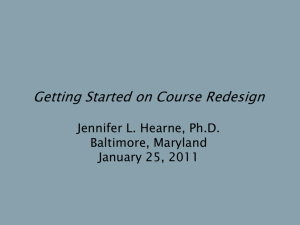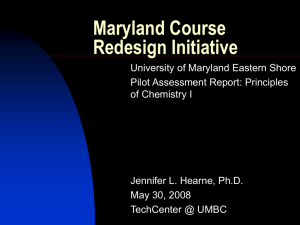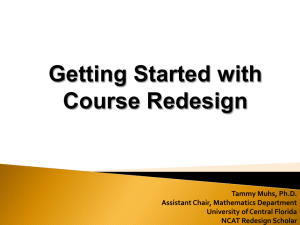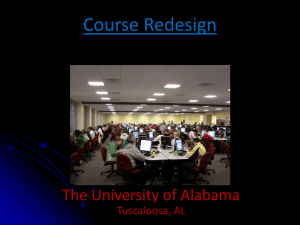Jennifer Hearne
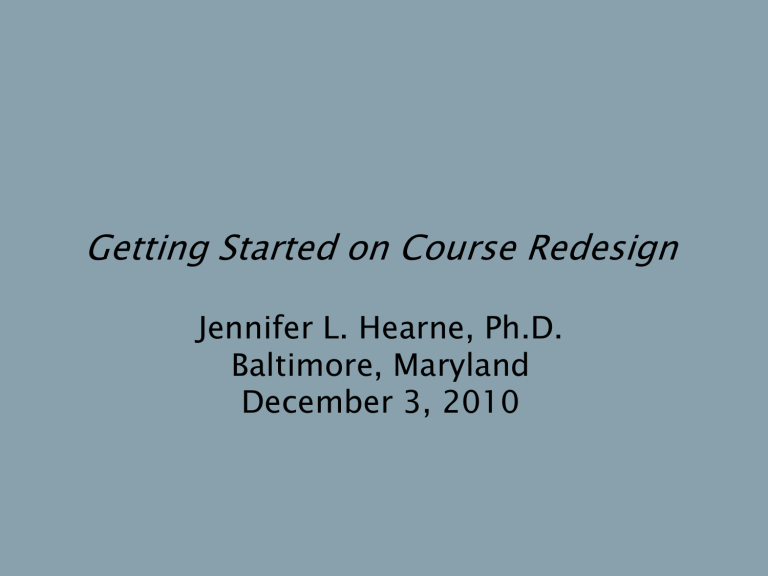
Getting Started on Course Redesign
Jennifer L. Hearne, Ph.D.
Baltimore, Maryland
December 3, 2010
OVERVIEW
• Institutional & Course Readiness
• NCAT & MCRI
• UMES Team
• Principles of Chemistry I
• Strategy
• Key Aspects
• Assessment
• Implementation Issues
• Motivational Factors
INSTITUTIONAL READINESS
Does your institution want to control or reduce costs?
Does your institution want to increase productivity?
• Academic productivity of students
• Academic course offerings
• Scholarly activity of faculty
Does this describe your course…
• High drop-failure-withdrawal rates
• Poor student performance in subsequent courses
• Creates a bottleneck
• Student & Departmental complaints
• Course drift -> Inconsistent learning outcomes
• Difficulty finding qualified personnel
NCAT & MCRI
Goals of the Maryland Course Redesign Initiative
• Adopt new ways to improve student learning outcomes
• Demonstrate these improvements through rigorous assessment
• Reduce institutional costs
• Release instructional resources for other purposes
• Develop the internal capacity of USM Faculty and
Staff to continue the redesign process
UMES & MCRI
University System of Maryland
University of Maryland Eastern Shore
Thelma B. Thompson, Ph.D., President
Charles Williams, Ph.D., Vice President for
Academic Affairs
MCRI Team at UMES
Joseph M. Okoh, Ph.D.
Yan Y. Waguespack, Ph.D.
Gladys G. Shelton, Ph.D
Charles Williams, Ph.D.
Amelia G. Potter
James R. Hayes
Principles of Chemistry I
Population
• Caters to science and health professions students
• 20% of freshman class
• 73% Freshman
• 6% nontraditional
Goals
• Basic atomic and molecular theory
• Nomenclature
• Reaction stoichiometry
• Gas laws
Principles of Chemistry I
Academic Issues
• Inconsistent knowledge of incoming students
• 55% student retention rate
• Lack of coordination among the professors teaching the sections of the course leading to course drift and inconsistent learning outcomes
NCAT REPLACEMENT MODEL
• Replaces in-class time with online, interactive learning activities
• Assumes that certain activities can be better accomplished online
• May keep remaining in-class activities the same or may make significant changes
• May schedule out-of-class activities in computer lab or totally online so that students can participate anytime, anywhere
KEY ASPECTS OF REDESIGN
Infusion of technology components
Integrated staffing
Individualized, active assistance
Restructure the course
REDESIGN STRATEGY
NCAT Principle #1: Redesign the whole course.
• Restructure the course - Chemistry 111E
Results: Eliminates course drift, duplication of effort and creates opportunities for integrated staffing
REDESIGN STRATEGY
NCAT Principle #2: Encourage active learning.
• Incorporate technology-based exercises
• Recitation or PBL session (aka Resuscitation)
Results: Student learning and interaction with materials/each other, reduced faculty preparation and presentation time and reduced grading time.
REDESIGN STRATEGY
NCAT Principle #3: Provide students with individualized assistance.
• Dedicated Computer Lab
• Integrated Staffing: Undergraduate Learning
Assistants (ULAs) and Learning Assistants (LAs)
• Recitation
Results: Students are provided with help when they need it (electronic or human intervention).
REDESIGN STRATEGY
NCAT Principle #4: Build in ongoing assessment and prompt (automatic) feedback.
• Technology-based program
• Hints
• Provides solutions
• Instantaneous grading
• Cumulative grade postings
Results: Enables practice, diagnostic feedback and focused time on task.
REDESIGN STRATEGY
Principle #5: Ensure time on task and monitor student progress.
• Web-based program/software can monitor a student’s activity
• Classroom management system implementation
• ULAs/LA monitor students’ time-on-task
Results: Milestone-learning and cost effectiveness
KEY ASPECTS OF REDESIGN
Infusion of technology components
Integrated staffing
Individualized, active assistance
Restructure the course
INFUSION OF TECHNOLOGY
Blackboard
CengageNOW http://login.cengage.com/sso//
• Tutorials and exercises that can be repeated in an attempt to earn a perfect score
• Hints/Answers -> Instantaneous grading
• Grade management
• Monitors time-on-task
Establishment of a Chemistry Computer Lab
INDIVIDUALIZED ASSISTANCE &
INTEGRATED STAFFING
• Undergraduate Learning Assistant (ULA) and
Learning Assistant (LA)
– monitor students’ time-on-task in computer lab
– Offer on-demand assistance
• Cumulative grade posted every Monday
– Office door/Blackboard
– CengageNOW grade available in student account
• Call or text from 8AM-9PM
RESTRUCTURED CHEMISTRY 111
Course
Traditional
Chemistry 111
Pilot
Chemistry
111E
Chemistry
111E
Section
Size
30-40
Up to
80
Up to
114
Meetings
MWF
50 min
M
75 min + 2h in computer lab
Recitation offered
MW
50 minutes +
1h in computer lab
Sections /
Professors per academic year
7/6
1
3/2
Learning
Assistant
No
Yes
Yes
ASSESSMENT
• Minimize differences between the student populations in the traditional and pilot section offerings
• Be sure that you use the same measures and procedures to collect the data for the pilot and full implementation.
• Choose the measurement method.
Pilot Phase
• Parallel Sections – Compare traditional sections and redesign sections.
• Comparisons of course grades
SUCCESS OF STUDENTS
70
60
50
40
30
20
10
0
A B C D F W A-C
Traditional 12,1 18,2 24,2 18,2 21,2 6,1 54,5
Pilot 17,2 31,3 17,2 15,6 4,7 14,1 65,7
70
60
50
40
30
20
10
0
Traditional
Pilot Redesign
A
12,1
B
18,2
C
24,2
D
18,2
F
21,1
W
6,1
A-C
54,5
17,2 31,3 17,2 15,8 5,7 14,1 65,7
Full Implementation F08 14,4 24 16,4 10 30,4 3,9 54,9
Full Implementation S09 18 24,4 27 7,2 18 5,4 69,4
Full Implementation F09 13,1 19,2 25,3 19,2 10,1 13,1 57,6
Traditional: 3, 50 min classes
Pilot : 75 min classes, 2h in designated computer lab, 1 full-time LA
Full Implementation F08: 2, 50 min classes, 2h in campus computer lab, 1 full-time LA + one ULA
Full Implementation S09: 2, 50 min class periods, 1h in chemistry computer lab, 1 full-time LA
Full Implementation F09: 2, 50 min classes, 1h in chemistry computer lab, 7 tutors, 2 ULAs, one TA
Traditional Course
54.5% A-C
61.1% enrolled in
CHEM 112
54.5% A-C, S
Pilot Course
65.7% A-C
61.8% enrolled in
CHEM112
61.9% earned A-C
In comparison to students enrolled in the Traditional course, Pilot course students were:
7.4% more likely to earn A-C in Chemistry 112
More likely to earn A, B grades in Chemistry 112
COST ASSESSMENT
300
250
200
150
100
50
0
Traditional
Pilot
Full Implementation
Population Institutional
Cost per
Student
33 268
76
220
151
80
Cost to
Student
200
265
105
WHAT HAPPENS TO THE SAVINGS?
• Stay in department for continuous course improvement and/or redesign
• BIOL111
• CHEM112
• Provide a greater range of offerings at upper division or graduate level
• Accommodate greater numbers of students with same resources
• Stay in department to reduce teaching load and provide more time for research
IMPLEMENTATION ISSUES
• Faculty perspectives
• Student expectations and knowledge
• Technology
• Administrative issues
– Scheduling
– Teaching load
MOTIVATIONAL
FACTORS
Professional Development Opportunities
Publications
Presentations
Publicity
Increased opportunity to work directly with students who need help
Reduced time spent on grading
Ability to try different approaches to meet different student needs
Opportunity for continuous improvement of materials and approaches
ACKNOWLEDGEMENTS
NCAT – Carolyn Jarmon and Carol Twigg
USM – Don Spicer, Nancy Shapiro and Stan Jakubik
UMES –Team, Administration, ULAs and LAs, MARC
U*STAR and MBRS RISE Programs
